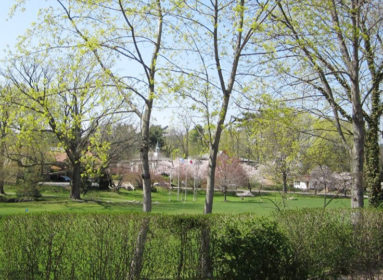By Mara Dresner
Since 2006, collaborators Sharon Eyal and Gai Behar have been a significant voice in the Israeli artistic community, creating a continuous stream of critically acclaimed original works for the Batsheva Dance Company and other eminent dance companies around the world. Their dance company L-E-V is the culmination of years of that momentum.
L-E-V debuted in the United States July 24 at Jacob’s Pillow Dance in the Berkshires and will run through July 28. In its much-anticipated U.S. debut, the exquisite dancers of L-E-V, including Sharon Eyal herself, will perform the provocative work HOUSE. With intense choreography by Eyal, an eclectic soundtrack by experimental musician Ori Lichtik, and lighting by acclaimed designer Bambi, HOUSE is an alluring spectacle of hypnotic sensuality and raw physicality.
Company manager Douglas Letheren, a New Hampshire native and founding member of L-E-V, as well as Jacob’s Pillow alumnus, took time to chat with the Ledger. Letheren has studied at St. Paul’s School, the Conservatoire de Rennes, and the Juilliard School, where he received his BFA in 2007. He has worked with Aszure Barton and as a guest artist with Les Ballets Jazz de Montreal, and was a member of Mikhail Baryshnikov’s Hell’s Kitchen Dance. He joined the Batsheva Ensemble in 2007 and the Batsheva Dance Company from 2008 till 2012, where he studied Gaga and worked with Ohad Naharin and Eyal Behar. He is a recipient of the 2007 MOVADO Future Legends Award, nominated by Mikhail Baryshnikov.
Q. How did you end up in Israel?
A. When I was student at Julliard, there was a piece by the choreographer from [the] Batsheva [Dance Company] and I felt immediately connected to it. … I’d never seen dancers move like that before. The dancers were trained in Gaga – their movement, their language, it was just something completely new for the dance world. I’d never seen it before; it was almost like a foreign language that I could immediately understand and connect to. It was very natural and free, powerful and dynamic at the same time.
I’m a fan of other dance techniques … They all have this codified language based on the form. For me, Gaga included that and opened up the whole package to include everything else at the same time. [I met Ohad Naharin] and stayed in touch with him and joined his ensemble. After a year in the ensemble, I joined the company [Batsheva Dance Company]. I’ve been there [in Israel] for six years now.
Q. What role does dance play in Israeli society?
A. The dance scene in Israel is really big and vibrant for a small country, that’s for sure surprising. It seems the audience for dance really exists; it’s always well attended. In terms of the way I see dance, it’s tricky. I live in Tel Aviv, and Tel Aviv is such a bubble. Most of the dance scene is happening in Tel Aviv. Obviously, I believe in art as a mirror and a healer. I think if I thought dance were to make a difference in Israel, we would have to branch out more, and now that I have a bit more time, after leaving Batsheva, I want to research that.
Q. Tell me how L-E-V came to be.
A. Sharon was the second in command for Batsheva. So she was creating and Ohad would create. Basically for a variety of reasons, it made sense for Sharon and Gal to create a platform for their own work; a neutral, blank slate. Batsheva is an amazing, amazing place and it’s so connected to Ohad; he’s one of the greatest choreographers of now. It was just on a lot of levels hard for Sharon’s voice to kind of break out of that. And so, slowly, very difficultly, with a lot of trial and error, L-E-V found its way, got its feet on its ground.
It was almost two years ago and I was actually planning on leaving Batsheva to go to a Buddhist monastery in Nova Scotia for a year. When I told Sharon, she said, “Are you sure this is what you want to do?” I believe in them so much; I wanted to build this thing with them. It felt so right. I’ve been helping them a lot administratively. In the beginning, I asked the question in passing – if you need any help with anything, I can help out. It’s been like falling into a raging river. It’s been an amazing learning experience and exciting and really challenging; it’s been great.
And now finally things are getting to a more functional place, so now I can pass on responsibilities in administration to other people in administration so I can concentrate on dancing because the administration is a huge amount of work.
Q. What is its mission?
A. That’s funny – at some point we wanted to incorporate that into some material and we never actually got around to having that meeting nine months ago to really talk about it. I can say what my personal feeling is; I can’t speak for everybody.
I would say one thing that comes to mind is being able to function in a more mainstream way, mainstream and also across other disciplines. For example, dance kind of has a pretty set groove where it’s running in general. A show has a premiere; it tours around different theaters. So far with L-E-V, things have been much more malleable. We’re really changing our performances. Our pieces to adapt to whatever space we’re going into.
This year we did a range of things. Our first thing was a new creation in Sweden. And then later on, we did work in an abandoned leprosy hospital in Jerusalem for the Israel Festival, building everything from scratch. There was nothing there; we had to generate own electricity. This was a huge project. It had a lot of challenges and difficulties.
We immediately had to adapt to another space in Tel Aviv that was basically a nightclub, a big stage with a bar in the middle, so people could get drinks even during the show. People were standing up by the stage like a rock concert. It sounds obvious and simple, but I’d never seen anything like it before. You take this context and put something serious, something meaningful there, and blend it seamlessly. It was such a different vibe for all of us to perform there. A lot of the choreography was familiar, but all of sudden it was a really new piece. We were shocked by the energy of the audience. They were screaming; there was this rock show vibe. It felt like we were floating in the middle of nowhere, not knowing what we were doing. It was a rush and I really enjoyed it.
Q. What can people expect when they come to see the piece at Jacob’s Pillow?
A. The piece we’re doing there was created a couple of years ago. It’s a really exciting show in three sections. The first operates on different tableaus which definitely has for me a kind of a portrait of human relationships, how we all kind of function very similarly, while feeling alone and very different. And then there’s another section, and the last section is these finale, [with] these gold shimmering unitards and pop music. The reason I mention that section is the way it complements [the first section] is very strong. … The third section takes it to whole other place. You realize it’s a different expression of the same thing. It just really just opens your brain; it’s really exciting for me.
HOUSE performed by the L-E-V dance company will run through 28 at Jacob’s Pillow Dance, 358 George Carter Road, Becket, Mass. For tickets and other information call (413) 243-0745 or visit jacobspillow.org.
Mara Dresner is a freelance writer living in Rocky Hill.








 Southern New England Jewish Ledger
Southern New England Jewish Ledger









